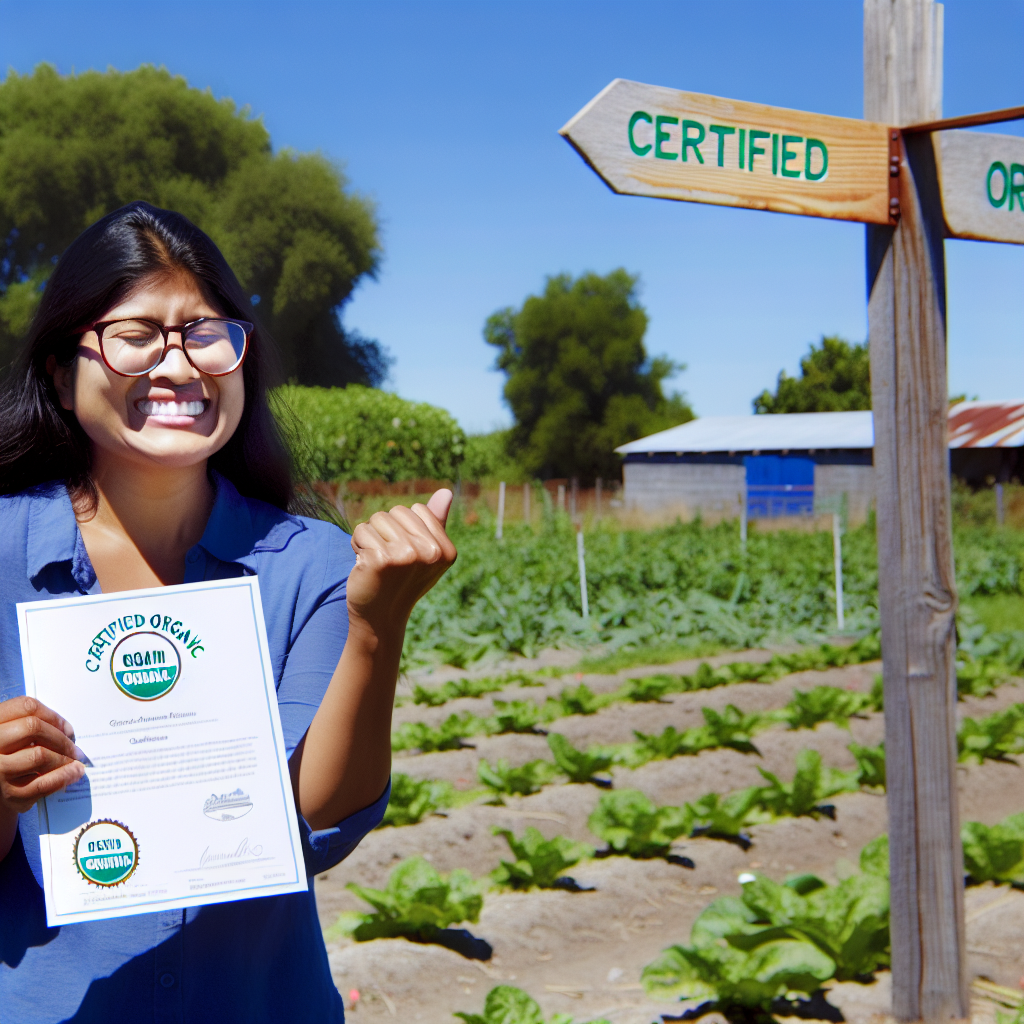Understanding the Basics of Organic Certification
Definition of Organic Certification
Organic certification verifies that agricultural products meet specific standards.
These standards include farming practices that maintain environmental balance.
Certification ensures products contain no synthetic fertilizers or pesticides.
Importance of Organic Certification
Organic certification enhances credibility among consumers.
It provides assurance regarding the absence of harmful chemicals.
Furthermore, certified organic products often demand higher market prices.
Key Regulations and Standards
Certification involves adherence to specific regulations set by governing bodies.
In the U.S., the USDA oversees organic certification.
Each country has its own regulatory framework for organic practices.
Steps to Obtain Organic Certification
The process begins with familiarizing yourself with organic standards.
Next, you should implement the required organic practices on your farm.
Documentation is crucial for demonstrating compliance with organic standards.
Choosing a Certifying Agent
Selecting an appropriate certifying agent is essential.
Seek agents accredited by recognized organizations.
Ensure they have experience with your type of agricultural products.
Transform Your Agribusiness
Unlock your farm's potential with expert advice tailored to your needs. Get actionable steps that drive real results.
Get StartedMaintaining Certification
Once certified, you must consistently follow organic practices.
Regular audits will assess compliance with organic standards.
Additionally, staying updated on changing regulations is vital.
Researching Certification Organizations and Standards
Understanding Certification Organizations
Certification organizations play a critical role in the organic certification process.
They establish standards that must be met for organic labeling.
Recognizing reputable organizations is essential for farmers.
For example, the USDA is a well-known certifying body in the United States.
Moreover, each organization may have different standards and requirements.
Identifying Standards for Organic Certification
Standards dictate what can and cannot be used in organic farming.
These guidelines cover everything from soil health to pest management.
Familiarizing yourself with these standards helps ensure compliance.
Additionally, understanding these regulations can prevent costly mistakes.
Conducting Research on Certification Bodies
Start by listing potential certification organizations relevant to your location.
Use online resources, like official websites, to gather information.
Check reviews and testimonials from other farmers who have worked with these organizations.
Consider contacting organizations directly for further details.
This proactive approach will help you choose the right certifier.
Comparing Certification Processes
Each organization has its own certification process, so compare them effectively.
Note differences in application procedures, fees, and timelines.
Some organizations may require additional documentation or inspections.
Take the time to evaluate these aspects carefully.
A thorough comparison can save you time and money later on.
Seeking Expert Guidance
Consulting with experts in organic farming can provide valuable insights.
Consider reaching out to local agricultural extensions or organic farming groups.
Showcase Your Farming Business
Publish your professional farming services profile on our blog for a one-time fee of $200 and reach a dedicated audience of farmers and agribusiness owners.
Publish Your ProfileThese experts can share experiences or recommend specific certification bodies.
Your local farming community can also be a source of information.
Building connections helps in navigating the certification landscape.
Creating an Organic System Plan
Importance of an Organic System Plan
An Organic System Plan (OSP) is vital for achieving organic certification.
This plan outlines production practices and management strategies.
Additionally, it ensures compliance with organic regulations.
Components of an Organic System Plan
An OSP should include specific information about your operation.
Begin with a description of your farm or facility.
Include details about the crops or livestock you plan to manage.
Next, outline your practices for planting and harvesting.
Don’t forget to mention pest and weed management strategies.
Moreover, your soil management practices play a crucial role.
Lastly, include information on post-harvest handling and processing.
Steps to Develop Your Organic System Plan
First, gather all necessary information about your farming practices.
Second, consult the USDA National Organic Program guidelines.
Third, document your current practices like planting and livestock care.
Next, identify any changes required to meet organic standards.
After that, create a written plan detailing all practices.
Then, review and revise the plan as needed.
Finally, ensure that all relevant materials are in place for certification.
Maintaining Your Organic System Plan
Regular updates to your OSP are essential for ongoing compliance.
Conduct annual reviews to ensure practices remain in line with standards.
Document any changes in practices or management strategies.
Keep records of inputs used and produce sold.
This transparency supports a successful certification process.
Engage with your certifying agent for guidance and feedback.
Delve into the Subject: Renewal Guidelines For Organic Certification
Implementing Organic Practices in Farming Operations
Understanding Organic Principles
Organic farming relies on natural processes and biodiversity.
It avoids synthetic pesticides and fertilizers that may harm ecosystems.
This approach prioritizes soil health and sustainable crop production.
Assessing Current Farming Practices
Begin by evaluating your existing farming methods.
Identify areas where organic practices can be implemented.
Consider your crop rotation, pest control, and soil management techniques.
Soil Management Techniques
Improving soil health is crucial for organic farming.
Incorporate compost and organic matter into the soil.
Utilize cover crops to prevent erosion and enhance nutrient content.
Regularly test soil to monitor its health and nutrient levels.
Pest and Weed Control Strategies
Implement integrated pest management to address pest issues.
Encourage beneficial insects that naturally reduce pest populations.
Consider physical barriers and traps to manage pests effectively.
Showcase Your Farming Business
Publish your professional farming services profile on our blog for a one-time fee of $200 and reach a dedicated audience of farmers and agribusiness owners.
Publish Your ProfileEmploy mulching and crop rotation to suppress weed growth.
Crop Variety Selection
Select varieties that are well-suited to your local climate.
Opt for disease-resistant crops to minimize chemical interventions.
Diverse plantings enhance resilience against pests and diseases.
Certification Process Overview
Familiarize yourself with organic certification requirements.
Contact a certifying agent to understand the specific guidelines.
Document all practices and adjustments made in your operations.
Maintaining Organic Status
Regularly review your practices to adhere to organic standards.
Stay updated on changes in organic regulations and best practices.
Engage with organic farming communities for support and resources.
You Might Also Like: Understanding Agricultural Land Use Restrictions
Documenting Farming Practices and Inputs Used
Importance of Documentation
Documentation is essential for achieving organic certification.
It helps verify compliance with organic standards.
Furthermore, clear records streamline the certification process.
Types of Documentation Required
Farms must maintain several key documents.
First, a comprehensive farm plan outlines practices and inputs.
This plan should detail soil management and crop rotation.
Also, keep records of pest and disease management strategies.
Additionally, document all inputs used, such as seeds and fertilizers.
Record-Keeping Practices
Effective record-keeping is crucial for organic farms.
Use digital tools or manual logs to maintain accurate records.
Ensure that records are easy to review and understand.
Regularly update your records to reflect current practices.
Examples of Required Records
- Input invoices and labels for all purchased products.
- Field maps showing crop layouts and rotation schedules.
- Records of soil amendments and their application dates.
- Pest and disease monitoring logs.
- Harvest and yield records for each crop.
Reviewing and Auditing Records
Conduct regular reviews of your documentation.
This practice helps identify areas that may need improvement.
Additionally, prepare for potential audits by certifying bodies.
Make sure all records are complete and readily accessible.
Discover More: The Role of GMO Laws in Sustainable Agricultural Practices
Developing Soil and Crop Management Plans
Understanding Soil Health
Soy health is the foundation of organic farming success.
You must regularly assess soil conditions to maintain productivity.
Healthy soil contains a diverse community of microorganisms.
This biodiversity promotes soil structure and nutrient availability.
Regular soil testing helps determine pH and nutrient levels.
Implementing Crop Rotation
Crop rotation enhances soil fertility and reduces pest issues.
Alternating crops prevents nutrient depletion from a single crop type.
Include legumes in your rotation to naturally fix nitrogen in the soil.
Additionally, diverse planting schedules disrupt pest life cycles effectively.
Utilizing Organic Amendments
Organic amendments improve soil structure and fertility.
Incorporate compost to boost microbial activity and nutrient content.
Organic fertilizers release nutrients slowly and reduce leaching.
Showcase Your Farming Business
Publish your professional farming services profile on our blog for a one-time fee of $200 and reach a dedicated audience of farmers and agribusiness owners.
Publish Your ProfileUsing cover crops can enhance organic matter and prevent erosion.
Implementing Integrated Pest Management
Integrated Pest Management (IPM) combines various strategies to control pests.
Start by monitoring pest populations and identifying beneficial insects.
Encourage habitat for natural predators within your farming system.
Use organic pesticides only as a last resort to control outbreaks.
Creating a Planting Schedule
A well-planned planting schedule maximizes harvest efficiency.
Consider local climate patterns when planning your crop dates.
Implement succession planting to extend the harvest period for some crops.
This method ensures continued productivity throughout the growing season.
Maintaining Documentation
Keep thorough records of all management practices and inputs.
This documentation supports transparency in the organic certification process.
Regularly update records to track progress and make informed decisions.
Reviewing historical data helps refine future management strategies.
Engaging in Continuous Education
Stay informed about the latest organic farming practices and regulations.
Attend workshops and conferences to learn from experienced farmers.
Join local or online farming communities to share knowledge and resources.
Continuous learning enhances your farm’s sustainability and resilience.
Learn More: Maintaining Compliance With Organic Regulations

Undergoing Initial Inspection by Certifying Agent
Understanding the Initial Inspection Process
The initial inspection is a critical step for organic certification.
It ensures compliance with the National Organic Program standards.
During this stage, a qualified certifying agent evaluates your practices.
This evaluation includes a thorough review of your operation.
Preparing for the Inspection
Preparation is key to a successful inspection.
Gather all necessary documentation related to organic practices.
This may include planting records, input purchases, and harvest logs.
Next, ensure that your fields and facilities are clean and accessible.
Additionally, staff members should be informed regarding inspection processes.
What to Expect During the Inspection
The inspector will arrive on a scheduled date for the evaluation.
They will inspect your land, livestock, and facilities.
Expect questions about your farming practices and organic inputs.
The inspector will also check your records for accuracy and consistency.
After the Inspection
Once the inspection is complete, the inspector will compile a report.
This report includes observations and any identified non-compliances.
You will receive feedback on areas needing improvement.
After making necessary corrections, you may proceed with the certification process.
Managing the Transition Period to Organic Practices
Understanding the Transition Period
The transition period is crucial for achieving organic certification.
It typically lasts for three years for most crops.
Diversifying practices during this time is essential.
Farmers need to adjust methods gradually to meet organic standards.
Evaluating Current Practices
Begin by assessing existing farming practices.
Showcase Your Farming Business
Publish your professional farming services profile on our blog for a one-time fee of $200 and reach a dedicated audience of farmers and agribusiness owners.
Publish Your ProfileIdentify which methods are already in line with organic guidelines.
For example, evaluate pesticide use and soil management techniques.
This evaluation helps pinpoint areas for improvement.
Developing a Transition Plan
Create a comprehensive plan to transition to organic farming.
This plan should outline specific goals for each farming season.
Include timelines for adopting new practices and training staff.
Ensure the plan is flexible to adapt to challenges.
Educating Staff and Stakeholders
Training is vital for a successful transition.
Organize workshops to educate employees about organic practices.
Encourage open communication with all stakeholders.
Involve everyone in the transition process to foster commitment.
Monitoring Progress and Adjusting Practices
Regularly monitor progress throughout the transition period.
Use benchmarks to evaluate the effectiveness of new practices.
Maintain records of changes to track improvements.
Be prepared to adjust practices based on outcomes and feedback.
Seeking Guidance from Expert Resources
Consult with organic farming experts and organizations.
Utilize resources like the USDA and local extension services.
These organizations often provide valuable insights and support.
Networking with experienced organic farmers can also help.
Addressing Non-Compliance Issues and Reinspections
Understanding Non-Compliance Issues
Non-compliance issues can arise during the organic certification process.
These issues may include improper use of substances or inadequate record-keeping.
Moreover, environmental contamination can also result in non-compliance.
It is essential to identify these issues promptly.
Timely identification allows for effective remediation.
Implementing Corrective Actions
Once identified, you must implement corrective actions immediately.
Begin by reviewing your practices and procedures.
Involve your team in discussions to address the issues.
Additionally, consult with an organic certification expert for guidance.
Document all corrective actions meticulously for transparency.
Preparing for Reinspections
Reinspections are crucial for regaining compliance.
Prior to a reinspection, ensure all corrective measures are in place.
Review all practices and update your records accordingly.
Train your staff to be aware of organic standards and compliance requirements.
Finally, conduct internal audits to verify readiness for the inspection.
Engaging with Certification Bodies
Communication with your certifying agent is vital during this process.
Inform them of any changes implemented to address non-compliance.
Schedule the reinspection when confident in compliance efforts.
This proactive engagement demonstrates your commitment to adhering to standards.
Expect feedback and be prepared to make further adjustments if necessary.
Learning from Non-Compliance Issues
Use non-compliance experiences to improve your operations.
Showcase Your Farming Business
Publish your professional farming services profile on our blog for a one-time fee of $200 and reach a dedicated audience of farmers and agribusiness owners.
Publish Your ProfileDevelop a culture that prioritizes compliance and education.
Regularly review and update your practices to align with organic standards.
This continuous improvement will mitigate future compliance risks.
Ultimately, a diligent approach ensures long-term success in organic certification.
Maintaining Certification through Annual Renewals
Understanding Annual Renewals
Annual renewals are essential for maintaining organic certification.
They require thorough documentation of farming practices.
Additionally, they ensure compliance with organic standards.
Documentation Requirements
Farmers must keep detailed records of all inputs.
Use a system for tracking organic inputs, such as fertilizers and pest control.
Document all harvests, sales, and expenses regularly.
Engaging with Certification Bodies
Stay in contact with your certification agency throughout the year.
They can provide guidance on new regulations and standards.
Participate in mandatory inspections scheduled by the agency.
Timely Submission of Renewal Applications
Submit renewal applications well before the expiration date.
Check specific deadlines set by your certification agency.
Failure to submit on time may jeopardize your certification status.
Continuous Education and Training
Stay informed about organic farming practices and regulations.
Attend workshops, seminars, and online courses regularly.
This knowledge will assist in maintaining compliance and improving practices.
Addressing Non-compliance Issues
Be proactive in identifying potential non-compliance issues.
Resolve issues promptly to avoid complications during audits.
Consult with experts when facing challenges to ensure compliance.
Additional Resources
Organic 101: What the USDA Organic Label Means | Home
What is the Farm Bill? – National Sustainable Agriculture Coalition




